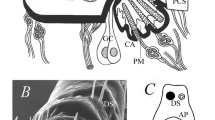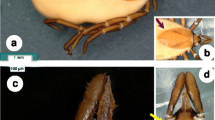Abstract
Analysis of available material on the structure of mouthparts, salivary glands, and behavior in two main groups of hard ticks (Prostriata and Metastriata), together with the analysis of molecular-genetic data, enlightening the initial stages of the evolution of hard ticks from a new side, allowed the author to assume a hypothesis on the secondary character of aphagy in males of the subfamily Ixodinae (genus Ixodes). Formation of aphagy in correlation with some other factors allowed representatives of the subfamily to reach evolutionary success comparable with that observed in representatives of other genera of Ixodidae (group Metastriata).





Similar content being viewed by others
REFERENCES
Arthur, D.R., Ticks and Diseases, Oxford: Pergamon Press, 1962.
Balashov, Yu.S., Coevolution of ixodid ticks and terrestrial vertebrates, Parazitologiya, 1989, vol. 23, no. 6, p. 457.
Balashov, Yu.S., Iksodovye kleshchi – parazity i perenoschiki infektsii (Ixodid Ticks – Parasites and Vectors of Infections), St. Petersburg: Nauka, 1998.
Balashov, Yu.S., Parazitizm kleshchei i nasekomykh na nazemnykh pozvonochnykh (Parasitism of acarines and insects on terrestrial vertebrates), SPb: Nauka, 2009.
Balashov, Yu.S., Grigoryeva, L.A., and Oliver, J., Reproductive isolation and interspecific hybridization of ixodid ticks of the group Ixodes ricinus – I. persulcatus (Acarina, Ixodidae), Entomol. Obozr., 1998, vol. 77, no. 3, p. 713.
Beati, L. and Klompen, H., Phylogeography of ticks (Acari: Ixodida), Annu. Rev. Entomol., 2019. https://doi.org/10.1146/annurev-ento-020117-043027
Black, W.C. and Roehrdanz, R.L., Mitochondrial gene order is not conserved in arthropods: Prostriate and Metastriate tick mitochondrial genomes, Mol. Biol. Evol., 1999, vol. 15, no. 12, p. 1772. https://doi.org/10.1093/oxfordjournals.molbev.a025903
Black, W.C. and Piesman, J., Phylogeny of hard and soft tick taxa (Acari: Ixodida) based on mitochondrial 16S rDNA sequences, Proc. Natl. Acad. Sci. U.S.A., 1994, vol. 91, p. 10034. https://doi.org/10.1073/pnas.91.21.10034
Bouman, E.A.P., Zemek, R., Dusbábek, F., and Socha, R., Sexual behavior of the sheep tick, Ixodes ricinus (L.) (Acari, Ixodidae), Proceedings of the 3rd International Conference on Urban Pests (Prague, 1999), Hronov, Czech Republic, 1999.
Emmanouel, N., Pelekassis, C., and Santas, L., Harmful mesostigmatic mites ectoparasitic to honey bees, Entomol. Hell., 1983, vol. 1, p. 17. https://doi.org/10.12681/eh.13889
Filippova, N.A., Multistage mechanism of reproductive isolation of closely related species Ixodes persulcatus and I. pavlovskyi (Ixodidae) in sympatric area, Parazitologiya, 2001, vol. 35, no. 5, p. 361.
Filippova, N.A., Ixodovye kleshchi podsemeistva Ixodinae. Fauna SSSR, Novaya seriya, 114, Paukoobraznye, Vol. 3, no. 4, (Ixodid ticks of the Subfamily Ixodinae), Leningrad: Nauka, 1977.
Grigoryeva, L.A., Histopathological changes of micromammalian skin in feeding places of the ticks Ixodes trianguliceps, I. persulcatus and I. ricinus (Ixodidae), Parazitologiya, 2001a, vol. 35, no. 3, p. 177.
Grigoryeva, L.A., Histopathologic changes of bird skin in feeding places of ticks of the genus Ixodes (Acari: Ixodidae), Parazitologiya, 2001b, vol. 35, no. 6, p. 490.
Grigoryeva, L.A., Histopathologic changes in a skin of lizard (Reptilia: Lacertidae) in feeding places of ticks of the genus Ixodes (Acari: Ixodidae), Parazitologiya, 2002, vol. 36, no. 5, p. 375.
Hermann, C. and Gern, L., Search for blood or water is influenced by Borrelia burgdorferi, in Ixodes ricinus, Parasit. Vectors, 2015. Vol. 8, p. 6. https://doi.org/10.1186/s13071-014-0526-2
Hoogstraal, H., Biology of ticks, in Tick Borne Diseases and Their Vectors, Wilde, J.K.H., Ed., Proceedings of International Conference, Edimburgh, September–October, University of Edinburgh, Centre for Tropical Veterinary Medicine, Edinburgh, 1978.
Hornok, S., Dermacentor marginatus (Sulzer, 1776), in Ticks of Europe and North Africa. A Guide to Species Identification, Estrada-Peña, A., Mihalca, A., and Petney, T.N., Eds., Springer, 2020a, p. 281. https://doi.org/10.1007/978-3-319-63760-0
Hornok, S., Ixodes ariadnae Hornok, 2014, in Ticks of Europe and North Africa. A Guide to Species Identification, Estrada-Peña, A., Mihalca, A., and Petney, T.N., Eds., Springer, 2020, 2020b, p. 109. https://doi.org/10.1007/978-3-319-63760-0
Jeyaprakash, A. and Hoy, M.J., First divergence time estimate of spiders, scorpions, mites and ticks (subphylum: Chelicerata) inferred from mitochondrial phylogeny, Exp. Appl. Acarol., 2009, vol. 17, p. 1. https://doi.org/10.1007/s10493-008-9203-5
Klompen, H., Holothyrids and ticks: new insights from larval morphology and DNA sequencing, with the description of a new species of Diplothyrus (Parasitiformes: Neothyridae), Acarologia, 2010, vol. 50, no. 2, p. 269. https://doi.org/10.1051/acarologia/20101970
Klompen, J.S.H., Black, W.C., Keirans, J.E., and Oliver, J.H., Evolution of ticks, Annu. Rev. Entomol., 1996, vol. 41, p. 141. https://doi.org/10.1146/annurev.en.41.010196.001041
Knülle, W. and Rudolf, D., Chapter 2. Humidity relationships and water balance of ticks, in Physiology of ticks, 1982, p. 43. https://doi.org/10.1016/B978-0-08-024937-7.50007-X
Kovalev, S.Y., Golovljova, I.V., and Mukhacheva, T.A., Natural hybridization between Ixodes ricinus and Ixodes persulcatus ticks evidenced by molecular genetics methods, Ticks and Tick-Borne Dis., 2016, vol. 7, no. 1, p. 113. https://doi.org/10.1016/j.ttbdis.2015.09.005
Leonovich, S.A., On the presence of a sexual pheromone in the ixodid tick Hyalomma asiaticum (Ixodidae), Parazitologiya, 1981, vol. 15, no. 2, p. 150.
Leonovich, S.A., Sensornye sistemy paraziticheskikh kleshchei (Sensory Systems of Parasitic Ticks and Mites), St. Petersburg: Nauka, 2005.
Leonovich, S.A., Comparative analysis of sexual behavior in ixodid ticks (Ixodidae), Parazitologiya, 2019a, vol. 53, no. 4, p. 294.
Leonovich, S.A., Types of parasitism of hard ticks (Ixodidae), Parazitologiya, 2019b, vol. 53, no. 5, p. 416. https://doi.org/10.1134/S0031184719050053
Leonovich, S.A. and Dusbabek, F., Pheromone receptive subsystem in ticks: correlation between stumulus conducting structures and evolution of behavior, in Modern Acarology (Academia (Prague) and SPB Publ. (The Hague), 1991, vol. 1, p. 53.
McCoy, K.D. and Tirard, C., Reproductive strategies of the seabird tick Ixodes uriae (Acari: Ixodidae), J. Parasitol., 2002, vol. 88, no. 4, p. 813. https://doi.org/10.1645/0022-3395(2002)088[0813:RSOTST]2.0.CO;2
Mihalca, A.D., Dumitrache, M.O., and D’Amico, G., Rhipicephalus rossicus Yakimov and Kol-Yakimova, 1911, in Ticks of Europe and North Africa. A Guide to Species Identification, Estrada-Peña, A., Mihalca, A., and Petney, T.N., Eds., Springer, 2020a, p. 311. https://doi.org/10.1007/978-3-319-63760-0
Mihalca, A.D., Pfäffle, M.P., and Petney, T.N., Hyalomma dromedarii Koch, 1844, in Ticks of Europe and North Africa. A Guide to Species Identification, Estrada-Peña, A., Mihalca, A., and Petney, T.N., Eds., Springer, 2020b, p. 365. https://doi.org/10.1007/978-3-319-63760-0
Mysterud, A., Hatlegjerde, I.L., and Sørensen, O.J., Attachment site selection of life stages of Ixodes ricinus ticks on a main large host in Europe, the red deer (Cervus elaphus), Parasit. Vectors, 2014, vol. 7, p. 510. https://doi.org/10.1186/s13071-014-0510-x
Nava, S., Guglielmone, A.A., and Mangold, A.J., An overview of systematics and evolution of ticks, Front. Biosci., 2009, vol. 14, p. 2857. http://www.bioscience.org/current/vol14.htm
Otranto, D., Dantas-Torres, F., and Santos-Silva, M.M., Ixodes ricinus (Linnaeus, 1758), in Ticks of Europe and North Africa. A Guide to Species Identification, Estrada-Peña, A., Mihalca, A., and Petney, T.N., Eds., Springer, 2020, p. 189. https://doi.org/10.1007/978-3-319-63760-0
Peñalver, E., Arillo, A., Delclòs, X., Peris, D., Anderson, S.R., Nascimbene, P.C., and Pérez-de la Fuente, R., Ticks parasitized feathered dinosaurs as revealed by Cretaceous amber assemblages, Nat. Commun., 2017, vol. 8, article number 1924. https://doi.org/10.1038/s41467-017-01550-z
Pfäffle, M. P., Petney, T.N., and Santos-Silva, M.M., Ixodes acuminatus Neumann, 1901, in Ticks of Europe and North Africa. A Guide to Species Identification, Estrada-Peña, A., Mihalca, A., and Petney, T.N., Eds., Springer, 2020a, p. 173. https://doi.org/10.1007/978-3-319-63760-0
Pfäffle, M. P., Petney, T.N., and Jaenson, T.G.T., Ixodes persulcatus Schulze, 1930, in Ticks of Europe and North Africa. A Guide to Species Identification, Estrada-Peña, A., Mihalca, A., and Petney, T.N., Eds., Springer, 2020b, p. 197. https://doi.org/10.1007/978-3-319-63760-0
Philips, J.S. and Sonenshine, D.E., Role of the male claw sensilla in the perception of female mounting sex pheromone in Dermacentor variabilis, Dermacentor andersoni and Amblyomma americanum, Exp. Appl. Acarol., 1993, vol. 17, p. 631.
Pomerantsev, B.I., Iksodovye kleshchi (Ixodidae). Fauna SSSR. Paukoobraznye (Ixodid ticks. Ixodidae. Arachnidae.(Ixodid ticks (Ixodidae). Fauna of USSR. Arachnids, 4 (2), Moscow: Izd. AN SSSR, 1950.
Repkina, L.V., Occurrence of hungry females of Ixodes persulcatus P. Sch. In nature, Meditsinskaya parazitologoya i parazitarnye bolezni 1973 vol. 2, p. 237.
Sándor, A.D., Ixodes canisuga Johnston, 1849, in Ticks of Europe and North Africa. A Guide to Species Identification, Estrada-Peña, A., Mihalca, A., and Petney, T.N., Eds., Springer, 2020a, p. 137. https://doi.org/10.1007/978-3-319-63760-0
Sándor, A.D., Ixodes hexagonus Leach, 1815, in Ticks of Europe and North Africa. A Guide to Species Identification, Estrada-Peña, A., Mihalca, A., and Petney, T.N., Eds., Springer, 2020b, p. 147. https://doi.org/10.1007/978-3-319-63760-0
Sándor, A.D., Ixodes lividus Koch, 1844, in Ticks of Europe and North Africa. A Guide to Species Identification, Estrada-Peña, A., Mihalca, A., and Petney, T.N., Eds., Springer, 2020c, p. 157. https://doi.org/10.1007/978-3-319-63760-0
Shao, R. and Barker, S.C., Mitochondrial genomes of parasitic arthropods: implications for studies of population genetics and evolution, Parasitology, 2007, vol. 134, p. 153.
Sonenshine, D.E., Tick pheromones and their use in tick control, Annu. Rev. Entomol., 2006, vol. 51, p. 557. https://doi.org/10.1146/annurev.ento.51.110104.151150
Taezhnyi kleshch Ixodes persulcatus Schulze (Acarina, Ixodidae): Morfologiya, sistematika, ekolofiya, meditsinskoe znachenie (Taiga Tick Ixodes persulcatus Schulze (Acarina, Ixodidae): Morphology, Taxonomy, Medical Importance), Leningrad: Nauka, 1985.
ACKNOWLEDGMENTS
The work was performed within the frame of the state theme “Elaboration of the modern basis of taxonomy and phylogenetics of parasitic and bloodsucking arthropods” (reg. no. АААА-А19-119020790133-6).
Author information
Authors and Affiliations
Corresponding author
Ethics declarations
Statement on the welfare of animals. All the applicable international, national, and institutional guidelines for the care and use of animals were followed. All the procedures performed in studies involving animals were in accordance with the ethical standards of the institution or practice at which the studies were conducted.
Rights and permissions
About this article
Cite this article
Leonovich, S.A. Male Aphagy in Hard Ticks of the Subfamily Ixodinae. Entmol. Rev. 102, 726–736 (2022). https://doi.org/10.1134/S0013873822050141
Received:
Revised:
Accepted:
Published:
Issue Date:
DOI: https://doi.org/10.1134/S0013873822050141




